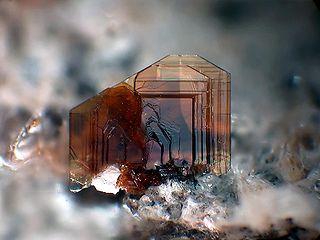
Biotite is a common group of phyllosilicate minerals within the mica group, with the approximate chemical formula K(Mg,Fe)3AlSi3O10(F,OH)2. It is primarily a solid-solution series between the iron-endmember annite, and the magnesium-endmember phlogopite; more aluminous end-members include siderophyllite and eastonite. Biotite was regarded as a mineral species by the International Mineralogical Association until 1998, when its status was changed to a mineral group. The term biotite is still used to describe unanalysed dark micas in the field. Biotite was named by J.F.L. Hausmann in 1847 in honor of the French physicist Jean-Baptiste Biot, who performed early research into the many optical properties of mica.

In geology and mineralogy, a mineral or mineral species is, broadly speaking, a solid substance with a fairly well-defined chemical composition and a specific crystal structure that occurs naturally in pure form.
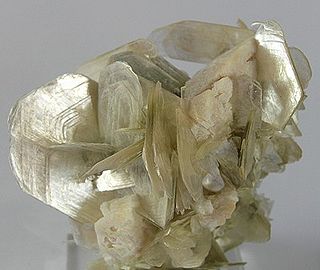
Muscovite (also known as common mica, isinglass, or potash mica) is a hydrated phyllosilicate mineral of aluminium and potassium with formula KAl2(AlSi3O10)(F,OH)2, or (KF)2(Al2O3)3(SiO2)6(H2O). It has a highly perfect basal cleavage yielding remarkably thin laminae (sheets) which are often highly elastic. Sheets of muscovite 5 meters × 3 meters (16.5 feet × 10 feet) have been found in Nellore, India.
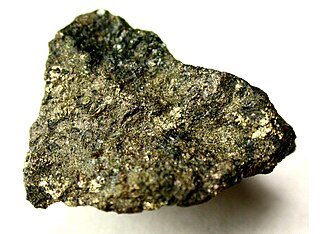
Pentlandite is an iron–nickel sulfide with the chemical formula (Fe,Ni)9S8. Pentlandite has a narrow variation range in nickel to iron ratios (Ni:Fe), but it is usually described as 1:1. In some cases, this ratio is skewed by the presence of pyrrhotite inclusions. It also contains minor cobalt, usually at low levels as a fraction of weight.
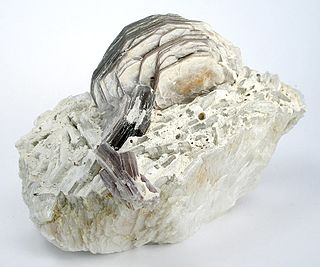
Lepidolite is a lilac-gray or rose-colored member of the mica group of minerals with chemical formula K(Li,Al)3(Al,Si,Rb)4O10(F,OH)2. It is the most abundant lithium-bearing mineral and is a secondary source of this metal. It is the major source of the alkali metal rubidium.
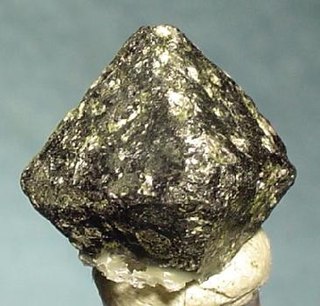
Chromite is a crystalline mineral composed primarily of iron(II) oxide and chromium(III) oxide compounds. It can be represented by the chemical formula of FeCr2O4. It is an oxide mineral belonging to the spinel group. The element magnesium can substitute for iron in variable amounts as it forms a solid solution with magnesiochromite (MgCr2O4). Substitution of the element aluminium can also occur, leading to hercynite (FeAl2O4). Chromite today is mined particularly to make stainless steel through the production of ferrochrome (FeCr), which is an iron-chromium alloy.

Braunite is a silicate mineral containing both di- and tri-valent manganese with the chemical formula: Mn2+Mn3+6[O8|SiO4]. Common impurities include iron, calcium, boron, barium, titanium, aluminium, and magnesium.
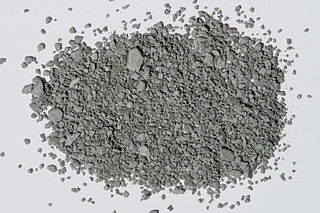
Illite, also called hydromica or hydromuscovite, is a group of closely related non-expanding clay minerals. Illite is a secondary mineral precipitate, and an example of a phyllosilicate, or layered alumino-silicate. Its structure is a 2:1 sandwich of silica tetrahedron (T) – alumina octahedron (O) – silica tetrahedron (T) layers. The space between this T-O-T sequence of layers is occupied by poorly hydrated potassium cations which are responsible for the absence of swelling. Structurally, illite is quite similar to muscovite with slightly more silicon, magnesium, iron, and water and slightly less tetrahedral aluminium and interlayer potassium. The chemical formula is given as (K,H3O)(Al,Mg,Fe)2(Si,Al)4O10[(OH)2·(H2O)], but there is considerable ion (isomorphic) substitution. It occurs as aggregates of small monoclinic grey to white crystals. Due to the small size, positive identification usually requires x-ray diffraction or SEM-EDS analysis. Illite occurs as an altered product of muscovite and feldspar in weathering and hydrothermal environments; it may be a component of sericite. It is common in sediments, soils, and argillaceous sedimentary rocks as well as in some low grade metamorphic rocks. The iron-rich member of the illite group, glauconite, in sediments can be differentiated by x-ray analysis.
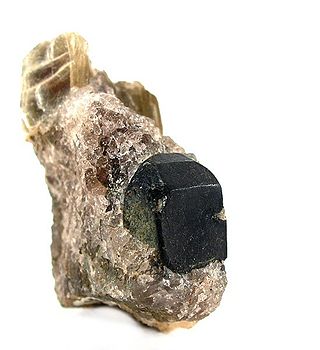
Triphylite is a lithium iron(II) phosphate mineral with the chemical formula LiFePO4. It is a member of the triphylite group and forms a complete solid solution series with the lithium manganese(II) phosphate, lithiophilite. Triphylite crystallizes in the orthorhombic crystal system. It rarely forms prismatic crystals and is more frequently found in hypidiomorphic rock. It is bluish- to greenish-gray in color, but upon alteration becomes brown to black.

Thaumasite is a calcium silicate mineral, containing Si atoms in unusual octahedral configuration, with chemical formula Ca3Si(OH)6(CO3)(SO4)·12H2O, also sometimes more simply written as CaSiO3·CaCO3·CaSO4·15H2O.
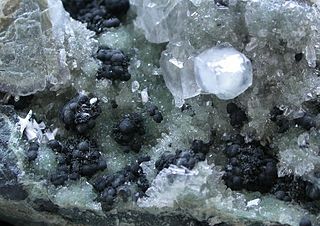
Julgoldite is a member of the pumpellyite mineral series, a series of minerals characterized by the chemical bonding of silica tetrahedra with alkali and transition metal cations. Julgoldites, along with more common minerals like epidote and vesuvianite, belong to the subclass of sorosilicates, the rock-forming minerals that contain SiO4 tetrahedra that share a common oxygen to form Si2O7 ions with a charge of 6− (Deer et al., 1996). Julgoldite has been recognized for its importance in low grade metamorphism, forming under shear stress accompanied by relatively low temperatures (Coombs, 1953). Julgoldite was named in honor of Professor Julian Royce Goldsmith (1918–1999) of the University of Chicago.

Perovskite (pronunciation: ) is a calcium titanium oxide mineral composed of calcium titanate (chemical formula CaTiO3). Its name is also applied to the class of compounds which have the same type of crystal structure as CaTiO3, known as the perovskite structure, which has a general chemical formula A2+B4+(X2−)3. Many different cations can be embedded in this structure, allowing the development of diverse engineered materials.
Alsakharovite-Zn (IMA symbol: Ask-Zn) is an extremely rare alkaline strontium zinc titanium silicate mineral from the cyclosilicates class, with the chemical formula NaSrKZn(Ti,Nb)4(Si4O12)2(O,OH)4·7H2O, from alkaline pegmatites. It belongs to the labuntsovite group.

Chamosite is the Fe2+end member of the chlorite group. A hydrous aluminium silicate of iron, which is produced in an environment of low-to-moderate-grade metamorphosed iron deposits, as gray or black crystals in oolitic iron ore. Like other chlorites, it is a product of the hydrothermal alteration of pyroxenes, amphiboles and biotite in igneous rock. The composition of chlorite is often related to that of the original igneous mineral, so that more Fe-rich chlorites are commonly found as replacements of the Fe-rich ferromagnesian minerals (Deer et al., 1992).
Banalsite is a rare barium, sodium aluminium silicate mineral with formula: BaNa2Al4Si4O16. Banalsite is a tectosilicate of the feldspar group.
Carbokentbrooksite is a very rare mineral of the eudialyte group, with formula (Na,□)12(Na,Ce)3Ca6Mn3Zr3NbSiO(Si9O27)2(Si3O9)2(OH)3(CO3).H2O. The original formula was extended to show the presence of cyclic silicate groups and silicon at the M4 site, according to the nomenclature of eudialyte group. Carbokenbrooksite characterizes in being carbonate-rich (the other eudialyte-group species with essential carbonate are zirsilite-(Ce), golyshevite, and mogovidite). It is also sodium rich, being sodium equivalent of zirsilite-(Ce), with which it is intimately associated.

Kentbrooksite is a moderately rare mineral of the eudialyte group, with chemical formula (Na,REE)15(Ca,REE)6Mn3Zr3NbSi[(Si9O27)2(Si3O9)2O2]F2·2H2O. This extended formula shows the presence of cyclic silicate groups and dominance of Si at the M4 site, according to the nomenclature of the eudialyte group. The characteristic features of kentbrooksite, that make it different from eudialyte are: (1) dominancy of fluorine (the only currently known example among the whole group), (2) dominancy of manganese, and (3) dominancy of niobium. Trace hafnium and magnesium are also reported. Kentbrooksite is relatively common when compared to most other species of the group.
Anzaite-(Ce) is a rare-earth element (REE) oxide mineral with the formula Ce4Fe2+Ti6O18(OH)2. An example of chemically related mineral is lucasite-(Ce), although it contains no iron. Cerium in anzaite-(Ce) is mainly substituted by neodymium, lanthanum, calcium and praseodymium. Titanium is substituted by niobium. Trace elements include thorium. The mineral is monoclinic, space group C2/m. Anzaite-(Ce) is hydrothermal mineral found in a carbonatite from the mineralogically prolific Kola Peninsula. The mineral name honors Anatoly N. Zaitsev, who is known for studies of carbonatites and REE.
Norra Kärr or Norra Kärr Alkaline Complex is an intrusive complex cropping out at the boundary between Östergötland and Småland, Sweden. The complex is chiefly made up of peralkaline nepheline syenite and is rich in exotic minerals. Rocks of the complex intruded into the Paleoproterozoic-aged Växjo granites of the Transscandinavian Igneous Belt. Alfred Elis Törnebohm was the first to describe the rocks of Norra Kärr in 1906. Norra Kärr was discovered a few years earlier during regional geological maping by the Swedish Geological Survey. The complex derives its name from a local farm, which translates into English as "Northern Fen". In 1968 Harry von Eckermann published his investigations on the complex defining its boundaries and confirming the view of it as an intrusion.

Wöhlerite, also known as woehlerite or wohlerite, is a member of the amphibole supergroup, and the wöhlerite subgroup within it. It was named after German chemist Friedrich Wöhler. It was first described by Scheerer in 1843, but the crystal structure was later solved by Mellino & Merlino in 1979. Once approved, it was grandfathered by the IMA.















